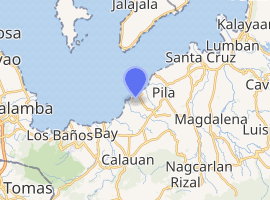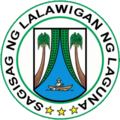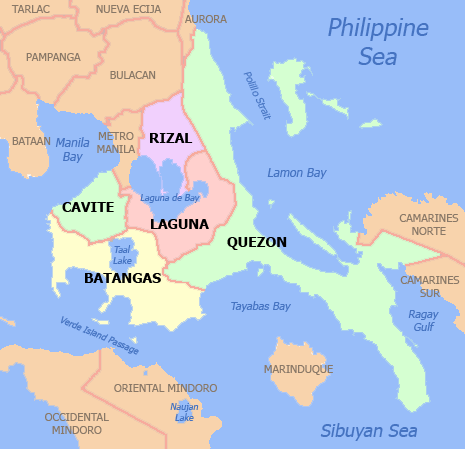Victoria, Laguna
Victoria, officially the Municipality of Victoria, (Tagalog: Bayan ng Victoria), is a 4th class municipality in the province of Laguna, Philippines. According to the 2015 census, it has a population of 39,321 people.[4]
Victoria | |
|---|---|
| Municipality of Victoria | |
Victoria Fields | |
 Seal | |
| Nickname(s): Duck Raising Capital of the Philippines[1] | |
 Map of Laguna with Victoria highlighted | |

| |
.svg.png) Victoria Location within the Philippines | |
| Coordinates: 14°13′30″N 121°19′30″E | |
| Country | |
| Region | Calabarzon (Region IV-A) |
| Province | Laguna |
| District | 3rd District |
| Founded | November 15, 1949 |
| Named for | Victoria Quirino |
| Barangays | 9 (see Barangays) |
| Government | |
| • Type | Sangguniang Bayan |
| • Mayor | Francisco S. Almeida |
| • Vice Mayor | Dwight C. Kampitan |
| • Congressman | Marisol A. Sampelo |
| • Electorate | 27,690 voters (2019) |
| Area | |
| • Total | 22.35 km2 (8.63 sq mi) |
| Elevation | 10.3 m (33.8 ft) |
| Population (2015 census)[4] | |
| • Total | 39,321 |
| • Density | 1,800/km2 (4,600/sq mi) |
| • Households | 10,362 |
| Economy | |
| • Income class | 4th municipal income class |
| • Poverty incidence | 4.4% (2015)[5] |
| • Revenue (₱) | 81,137,196.27 (2016) |
| Time zone | UTC+8 (PST) |
| ZIP code | 4011 |
| PSGC | |
| IDD : area code | +63 (0)49 |
| Climate type | tropical monsoon climate |
| Native languages | Tagalog |
It is southeast of Laguna de Bay, 90 kilometres (56 mi) south of Manila and bordered by the Municipality of Calauan to the south-west, Nagcarlan to the southeast and Pila to the north-east. The municipality has a total land area of 22.83 square kilometers which is 1.30% of the total land area of the province of Laguna.
History
Prominent citizens and civic leaders find new hope to make Nanhaya a town, when the Americans granted the Philippine Independence in 1946. They revived the move to separate from Pila. This time citizens proposed to name the town Trinidad, after the young republic’s First Lady, the wife of then President Manuel Roxas. Strong oppositions shelved the proposal once more.
After Roxas’ death, Elpidio Quirino took over the presidency. Nanhaya’s residents remained undaunted. They tried once more, intensifying the campaign. Most prominent and wealthiest family of the town is the Fernandez clans, Judge Jose Fernandez, then Mayor Alejandro Fernandez, Atty. Ramon H. Fernandez, Sr., Andres Franco, Dr. Agrifino Oca, Gregorio Herradura and Leonardo Rebong stood for the proposal. Victoria was a barrio of Pila until November 15, 1949, when President Elpidio Quirino signed into effect EO 282 segregating this barrio and 8 others into an independent community. Its name was adopted from President Quirino's daughter Victoria Quirino.[6]
After Pateros became highly urbanized and densely populated, Victoria became a destination of balut traders and became the "Duck Raising Center of the Philippines". The town was featured as the detour challenge of Leg 11 of the 5th Season of the Amazing Race. Victoria celebrate their Itik Festival every second week of November.
The capital of Pila was once in Barangay Pagalangan, now one of Victoria's barangays. What remains of Pila's original parish church can still be found in Pagalangan, which in the past made that community a target of treasure hunters seeking antiques. Pagalangan ceased to be Pila's capital when the town center was moved due to frequent flooding.[7]
Barangays
Victoria is politically subdivided into 9 barangays. Two of these, Nanhaya and San Roque, are classified as urban while the rest are rural. [3]
Climate
| Climate data for Victoria, Laguna | |||||||||||||
|---|---|---|---|---|---|---|---|---|---|---|---|---|---|
| Month | Jan | Feb | Mar | Apr | May | Jun | Jul | Aug | Sep | Oct | Nov | Dec | Year |
| Average high °C (°F) | 26 (79) |
27 (81) |
29 (84) |
31 (88) |
31 (88) |
30 (86) |
29 (84) |
29 (84) |
29 (84) |
29 (84) |
28 (82) |
26 (79) |
29 (84) |
| Average low °C (°F) | 22 (72) |
22 (72) |
22 (72) |
23 (73) |
24 (75) |
25 (77) |
24 (75) |
24 (75) |
24 (75) |
24 (75) |
24 (75) |
23 (73) |
23 (74) |
| Average precipitation mm (inches) | 58 (2.3) |
41 (1.6) |
32 (1.3) |
29 (1.1) |
91 (3.6) |
143 (5.6) |
181 (7.1) |
162 (6.4) |
172 (6.8) |
164 (6.5) |
113 (4.4) |
121 (4.8) |
1,307 (51.5) |
| Average rainy days | 13.4 | 9.3 | 9.1 | 9.8 | 19.1 | 22.9 | 26.6 | 24.9 | 25.0 | 21.4 | 16.5 | 16.5 | 214.5 |
| Source: Meteoblue [8] | |||||||||||||
Demographics
| Population census of Victoria | ||
|---|---|---|
| Year | Pop. | ±% p.a. |
| 1960 | 8,922 | — |
| 1970 | 12,741 | +3.62% |
| 1975 | 13,810 | +1.63% |
| 1980 | 16,522 | +3.65% |
| 1990 | 21,847 | +2.83% |
| 1995 | 25,424 | +2.88% |
| 2000 | 29,765 | +3.44% |
| 2007 | 33,829 | +1.78% |
| 2010 | 34,604 | +0.83% |
| 2015 | 39,321 | +2.46% |
| Source: Philippine Statistics Authority[4][9][10][11] | ||
In the 2015 census, the population of Victoria, Laguna, was 39,321 people,[4] with a density of 1,800 inhabitants per square kilometre or 4,700 inhabitants per square mile.
Local Government
Municipal officials 2019-2022:
- Mayor: ALMEDA, FRANKIE (NPC)
- Vice Mayor: KAMPITAN, DWIGHT (PDPLBN)
- Councilors:
- KAMPITAN, RJ (PDPLBN)
- REBONG, JAMES (PDPLBN)
- FERNANDEZ, CAYLENE PUSA (NP)
- HERRADURA, WILLY (NP)
- CORCUERA, JOY (PDPLBN)
- TOPE, MA. FE (NPC
- MASILANG, BUNSO (NP)
- VIBORA, BEMBE (NP)
- ABC President: Leoncio S. Fajardo
- SK President: John Patrick S. Cambe
- SB Secretary:
References
- Cadiz Duck Farm
- "Municipality". Quezon City, Philippines: Department of the Interior and Local Government. Retrieved 31 May 2013.
- "Province: Laguna". PSGC Interactive. Quezon City, Philippines: Philippine Statistics Authority. Retrieved 12 November 2016.
- Census of Population (2015). "Region IV-A (Calabarzon)". Total Population by Province, City, Municipality and Barangay. PSA. Retrieved 20 June 2016.
- "PSA releases the 2015 Municipal and City Level Poverty Estimates". Quezon City, Philippines. Retrieved 1 January 2020.
- http://laguna.com.ph/?q=node%2F137
- Remi E. de Leon (2005). "Health Knowledge Processes and Flows in a Coastal Community in Victoria, Laguna Philippines". University of the Philippines Los Baños Graduate School.
Master's Thesis
Cite journal requires|journal=(help) - "Victoria: Average Temperatures and Rainfall". Meteoblue. Retrieved 11 May 2020.
- Census of Population and Housing (2010). "Region IV-A (Calabarzon)". Total Population by Province, City, Municipality and Barangay. NSO. Retrieved 29 June 2016.
- Censuses of Population (1903–2007). "Region IV-A (Calabarzon)". Table 1. Population Enumerated in Various Censuses by Province/Highly Urbanized City: 1903 to 2007. NSO.
- "Province of Laguna". Municipality Population Data. Local Water Utilities Administration Research Division. Retrieved 17 December 2016.
External links
| Wikimedia Commons has media related to Victoria, Laguna. |

